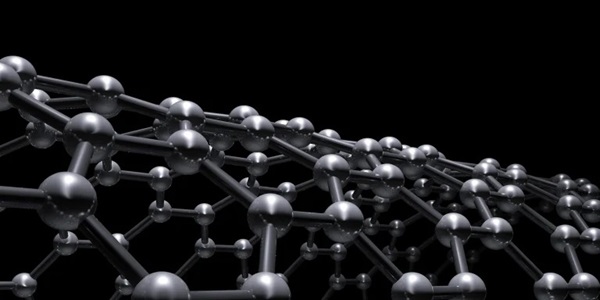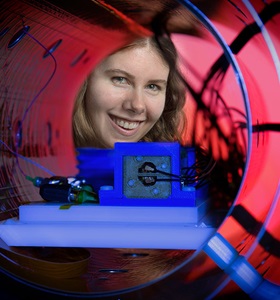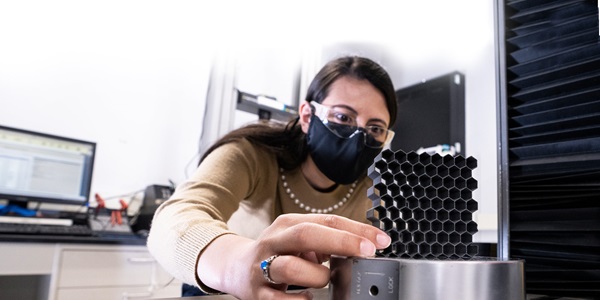Surviving Space

By Kelly McSweeney
Together, carbon nanotubes and additive manufacturing — also known as 3D printing — can help to solve two of the biggest challenges in aerospace engineering: electrostatic discharge (ESD) and radiation.
"We're looking at ways to use advanced materials and advanced manufacturing techniques to allow us to fly the latest and greatest hardware in space," says Brad Lyon, Ph.D., a staff systems engineer at Northrop Grumman.
"This will be an enabling technology, especially as we look beyond the moon and head to Mars."
— Randy Spicer, Senior Principal Engineer, Northrop Grumman

Nanomaterials and 3D Printing in Space
Engineers love carbon nanotubes (CNT) because their unique structure gives them properties that can solve many problems at once. They are extremely lightweight, which makes them ideal for reducing mass in certain space applications. Plus, their long aspect ratio (the long, skinny geometric shape) is ideal for blocking radiation and preventing ESD.
If you combine this material with additive manufacturing, engineers can create spacecraft components that are precisely customized to withstand harsh conditions in space. Better yet, as both technologies mature, it may be possible to use additive manufacturing to build infrastructure, such as a space station or a bridge for rovers traversing difficult terrain.
Researchers at Northrop Grumman are working to take this technology to the next level by ironing out the kinks of 3D printing in the vacuum of space. A typical 3D printer works by rapidly heating a small volume of plastic and then extruding it onto a layer of a part where the plastic rapidly cools. This sensitive thermodynamic process is especially challenging in a vacuum where there is no air for cooling the printer or the printed parts. Without proper cooling in a vacuum, pesky bubbles will appear in the printed material. Northrop Grumman engineers developed and tested a 3D printer that can operate in the vacuum of space and are developing techniques that can be used to print structures on-orbit.
Simultaneously, another group of engineers began experimenting with different nanomaterials to find the ideal recipes for space. They created small samples with different materials, concentrations and structures. Then, they tested the material by hitting it with radiation at testing labs and sending it into space on tiny research satellites called CubeSats.

Electrostatic Discharge (ESD)
ESD is a common engineering challenge, especially with electronics. But space creates a perfect storm that makes ESD a crucial element of any space design. Shuffling your socks across a carpet can create static buildup that causes a harmless spark when you touch something. But in an enclosed system such as an electronic device, those sparks can damage the components. On Earth, we can avoid ESD with grounding systems, such as a lab employee wearing a wrist strap that attaches them to the ground. In space, the plasma environment can cause large charges to build-up on surfaces of a spacecraft, creating even more potential for ESD that engineers must carefully take into account in their design.
This is why spacecraft materials have specific requirements; they have to be conductive so that, as charges build, they are safely dispersed. Otherwise, they could build up charge and create arcs that could damage the spacecraft. Plastic materials, such as the ones used in additive manufacturing, are usually not ESD-safe.
"We add carbon nanotubes to the polymer to make it conductive, so we can avoid that buildup of charge," explains Randy Spicer, Senior Principal Engineer at Northrop Grumman.
His team experimented with different ways of incorporating CNTs into plastic, which is tricky because the tubes tend to stick together. They worked with partners to develop manufacturing techniques to evenly disperse CNTs for consistent, reliable ESD protection.
"We're looking at ways to use advanced materials and advanced manufacturing techniques to allow us to fly the latest and greatest hardware in space."
— Brad Lyon, Ph.D., Staff Systems Engineer, Northrop Grumman

Radiation Protection
Radiation comes from several sources:
- Van Allen Belts, which are zones of charged particles, such as protons from solar wind
- Solar flares from the sun, which generate large amounts of protons that can damage electronics
- Galactic cosmic radiation, or high-energy protons and atomic nuclei that travel through the galaxy
Normally, we're protected by Earth's magnetic field and atmosphere. But in space, you have to manufacture radiation protection, and it has to be much lighter than the physical barriers we use on Earth, such as a heavy lead vest you might wear for a dental X-ray.
Once again, carbon nanotubes and other nanomaterials offer a solution. CNTs have hydrogen on the tips of the tubes, which helps to slow down any protons heading that way. Because of hydrogen's simple atomic structure, it can ideally block protons.
"It's like two billiard balls hitting each other," Lyon says. "The CNT's hydrogen redistributes the energy from the incoming proton." Applying this principle, Lyon and his colleagues use 3D printing to build shields containing nanomaterials for satellites. This allows them to equip satellites with cutting-edge electronics that were previously too delicate to withstand radiation in space.
Innovative Technology for Tomorrow
Just a few years ago, aerospace engineers only had a few options for shielding materials.
"Now, I can choose from hundreds of different nanoparticles — and because of 3D printing, I can design my shield layer by layer," says Lyon. "We're able to create mission-custom radiation shields."
These emerging technologies will help to reduce costs and manufacturing time, which will make space exploration more accessible.
"There's potential, as the technology matures, for building very large structures in space," says Spicer. He adds, "This will be an enabling technology, especially as we look beyond the moon and head to Mars."
More innovation stories
Read all stories about advanced technology and innovation >>


